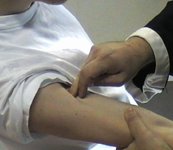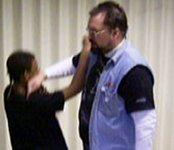The use of pressure-points in Wudang Weng Shun Kuen
by Rien Bul
The Dim Mak in Wudang Weng Shun Kuen is very basic and simplefied, but at the same time to the point and very effective. But learning Wudang Weng Shun Kuen does involve much more than just maiming and killing fellow human beings. A big part of the lessons I received from my Sifu were also spent on healing techniques. I was extensively tutored in the art of Chinese osteopathy and massage. When I asked my Sifu what this way of healing was called he just shrugged and answered "all just Gung Fu". He meant by this that it was also a part of the style. He also told me he would never teach anyone who was only interested in the fighting aspect of Wudang Weng Shun Kuen. He would shake his head and tell me in his broken Dutch, "No balance would be there".
Gung Fu, I learned, is a means to find balance in oneself and to learn to respect life. If one was to learn the weaknesses of the human anatomy to take away a possible threat by inflicting pain or wounds, or even to kill; one should also learn how to use an equal amount of knowledge to heal other humans. The student should learn to live his life using both his fighting and medical skills for the benefit of the human race. So the use of pressure points in Wudang Weng Shun Kuen works both ways.
Dar Mak and the "pain principle"
The bigger part of pressure-point fighting in Wudang Weng Shun Kuen is geared toward Dar Mak, instead of Dim Mak. To keep things simple; we call death-point striking "Dim Mak" and non-lethal use of pressure-points "Dar Mak". In Dar Mak we mostly make use of the so-called "pain principle". We inflict a sudden, sharp pain to interrupt an attack and at the same time make use of this short lapse to position ourselves in an advantageous position, from where were able to finish off the opponent. For information purposes I might add that at this point of the fight we could use a Dim Mak-strike. Of course, this applies to dire situations in which one would have no other choice than to kill an opponent.
"Energy draining" techniques
I guess you have understood by now the way Dar Mak is applied in Wudang Weng Shun Kuen. Especially with very aggressive opponents, who won’t stop fighting unless seriously hurt or who keep resisting even though you have them tightly restrained, you might want to make use of a very painful, but undamaging pressure point. In those situations knowledge on this matter might be helpful. A second kind of pressure-point within Dar Mak is the "energy draining" point. These points are about inflicting pain as well as draining the opponent’s energy, so he will weaken and drop on the spot. In the "Video" section of this site you can view a little demonstration of this technique. It is filmed during one of my lessons in the Dutch school. In it I am explaining these techniques and, while talking, quite casually touch a student on the shoulder. He immediately goes down, as described above. Nevertheless he wasn’t hurt more than a moment. These kinds of points are not dangerous to one’s health. But beware: all techniques that render a man unconscious are hazardous to ones health! Never allow anyone to knock you unconscious. Never! There are so called "experts" who demonstrate this sort of "lights-out" touch in seminars and such. Don’t let them do it to you. You might be rendered am invalid for life or be killed. Mark my words; one day, someone will be killed! It is just a matter of time.
Tiger and Dragon-claw techniques
I wasn’t aware of the influence of "Tiger" or "Tiger Claw" Kung Fu on (Wudang) Weng Shun Kuen until recently. Granted, we DO have the famous "Tiger tail kick" in our style’s curriculum, but that was about it. Some time ago Grandmaster Hoffmann of the (Sil Lum) Chi Sim Weng Chun Kuen branch was kind enough to send me his magnificent book on his style. I can’t thank him enough for this grand gesture and highly recommend his book to all Weng Shun Kuen enthusiasts. His style displays quite a few tiger techniques. I got curious and reviewed all hand techniques my Sifu taught me, looking for tiger-influences on my own particular style. Also, I had heard from other sources about an alledged Dragon (Loong Ying) style influence on Weng Shun Kuen. Like the Tiger style, Dragon-Kung Fu is well known for its gripping techniques. I found that the clawing grips my own Sifu taught me to use on pressure-points, bears a remarkable resemblance to both! I was just never told that these were either Tiger or Dragon Claw techniques. My Sifu never even called it "clawing". He just showed me the correct position the hand should have to apply the right amount of pressure on the right point and that was that! In his opinion, who would care about the technique’s name, as long as it worked? He was right, of course. Historically it is interesting, isn’t it?
Point location
Being a so called "limb-attacking style", it is obvious that Wudang Weng Shun Kuen makes use mostly of the pressure-points that are located in the area from the fingers up to the neck. As an aide with restraining an opponent we also make a lot of use of the vulnerable points located at the upper-back and the shoulders. For these points you can also use the tip of your elbow.
The Bil Jee form
If you, the reader, are an advanced student of Weng Shun Kuen or Wing Chun Kuen, I advise you to review the Bil Jee form with the knowledge from this article in mind. The Bil Jee form is meant for the third stage of combat (see the "Three stages of combat" article). This form has the techniques for re-positioning in case the practitioner is forced in an unadvatageous position as well as the Dar/Dim Mak techniques to take out the opponent. For this purpose,the fingers and the Phoenix Fist are the chosen weapons. Because the weak spots of the anatomy are the target, one is able to use the fingers without hurting them. Because of this fact, conditioning of the fingers is unnecessary.
Unreliable
Do not count on the effectiveness of Dar Mak. You should mostly rely on your basic techniques. Keep doing those correctly. People tend to get sloppy in their basic techniques when they’ve learned some nasty pressure-points. I have seen many make that mistake. Some people are impervious to some or any of them. People differ from one another. Some people are naturally resistant to pain, others get temporarily resistant because of the high level of adrenaline they build up during a fight. Others might have taken drugs that make them very resistant to pain. In other cases you might not get the point right. Do not be defeated by your own arrogance.
Disclaimer
The contents of the above article is meant for educational purposes only. No party involved in producing this informative website can be held in any way responsible for any kind of damage a person does to the health or possessions of neither himself or other persons while either exercising or actively practicing the presented information in any way. The information presented here is meant for preserving a unique historic martial system for future generations.


Click pictures to view Dar Mak Videos
A special thanks to Dwight Campbell for his help.